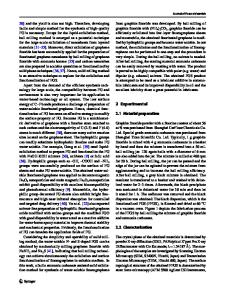Engineering of Graphene Band Structure by Haptic Functionalization
- PDF / 13,601,666 Bytes
- 6 Pages / 612 x 792 pts (letter) Page_size
- 33 Downloads / 379 Views
Engineering of Graphene Band Structure by Haptic Functionalization Paul Plachinda1 Raj Solanki1, and David Evans1,2 1 Department of Physics, Portland State University. 1719 SW 10th avenue. Portland, OR 972070751, U.S.A, 2 Sharp Laboratories of America, Inc. 5750 Northwest Pacific Rim Boulevard Camas, WA 98607-9489, U.S.A. ABSTRACT We have employed first-principles density-functional calculations to study the electronic characteristics of graphene functionalized by metal-bis-arene and metal-carbonyl molecules. It is shown that functionalization with M-bis-arene (M(C6H6)@gr, M=Ti, V, Cr, Mn, Fe) molecules leads to an opening in the band gap of graphene (up to 0.81eV for the Cr derivative), and functionalization with M-carbonyl (M(CX)3@gr, X=O,N; M= Cr, Mn, Fe, Co) up to one 1eV for M=Cr and X=O, and therefore transforms graphene from a semi-metal to a semiconductor. The band gap induced by attachment of a metal atom topped by a functionalizing group is attributed to modification of π-conjugation and depends on the concentration of functionalizing molecules, metal’s and moiety’s electronic structure. This approach offers a means of tailoring the band structure of graphene and potentially its applications for future electronic devices. INTRODUCTION Graphene continues to draw immense interest because of its unusual electronic properties resulting from a simple structure composed of a single layer of carbon atoms arranged in a 2dimensional honey-comb pattern [1,2]. These properties, including ballistic carrier transport and quantum Hall effect, make it a promising candidate as a building block of future nanoelectronic devices and as a possible replacement for silicon [3,4]. In spite of graphene’s amazing properties, there are some obstacles that need to be overcome before it can be considered as a viable candidate to replace silicon. The main barrier is absence of a band gap. Therefore, producing a band gap is probably one of the most important challenges that must be addressed before graphene can ultimately enable practical applications ranging from digital electronics to infrared nanophotonics. A number of possible solutions have been proposed and demonstrated for producing bandgaps in single-and double-layered graphene. Chemical modification of graphene by covalently functionalizing its surface potentially allows a wider flexibility in engineering electronic structure, in particular the local density of states of the carbon atoms bound to the modifier that can result in opening of the band gap. Methods have been developed to functionalize graphene covalently with molecular species [5,6]. Such methods usually result in distortion of graphene sheet geometry and rehybridization of carbon atoms from sp2 to sp3 [7–9]. For the distorted graphene sheets, each modifier creates a scattering center, which will act as a trap for electrons resulting in degradation of electron mobility. Therefore, our objective is to identify molecules, when covalently bonded to graphene, can break its conical band structure and open up an energy g
Data Loading...











